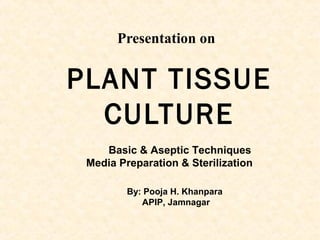
Planttissueculture by pooja
- 1. Presentation on PLANT TISSUE CULTURE Basic & Aseptic Techniques Media Preparation & Sterilization By: Pooja H. Khanpara APIP, Jamnagar
- 2. Basic Steps of PTC
- 3. Introduction Principles of plant tissue culture : Tissue culture simply directs and assistants the natural potential within the plant to put forth new growth and the multiply in highly efficiently and predictable way. Totipotency i.e is the capacity of an individual all to regenerate in to the whole plant, the concept of totipotency (T.H. Morgan, 1901). All the plant cells have their property since potential lies mainly in cellular differentiation.This indicates that all genes responsible for differentiation tissue or organ are able to express only under adequate culture conditions.
- 4. Introduction The three main changes or stages is the complete development an ordered change or progress often towards a higher more complex state of a cell are Cell division Cell elongation Cell Maturation Two kinds of plant growth are possible in vitro Organized Growth : Occurs either when organized plant parts or organs such as the growing point apical Meristem of shoots or roots leaf initials, young flower buds and small fruit are transferred to culture (where they may continue to grow with their structure preserved ) or when these structure are formed afresh during the culture of unorganized tissues. Unorganized Growth : Occurs when pieces of whole plant are cultured in vitro. The tissue thus formed typically lack any recognizable structure contain only limited no of the many different kinds of specialized cells found in an intact plant.
- 6. Basic TechniquesBasic Techniques Setting up of a tissue culture lab requires proper planning. It is divided into 5 areas Media preparation room Aseptic transfer area Culture room Analytical room Acclimatization room
- 7. Media Preparation RoomMedia Preparation Room Refrigerator & freezer Water purification & storage system Glassware washing facility Continuous supply of single & double distilled water Culture media, washing powder, disinfectants Cabinets or shelves
- 8. Aseptic Transfer AreaAseptic Transfer Area Laminar air flow Dissecting microscopes Dissection instruments Gas outlet Vacuum facility Sterilizer
- 9. Culture RoomCulture Room Environmentally controlled Incubators with controlled temperature Rotary shakers Lux meter Space for cultures requiring complete darkness
- 10. Analytical RoomAnalytical Room Colorimeter Low speed centrifuge Inverted centrifuge Chemical reagent racks Viscosity meter Gas outlet
- 11. Acclimatization RoomAcclimatization Room High illumination(4,000-10,000 lux) High humidity(90-100% through mist & fog systems)
- 12. Miscellaneous ItemsMiscellaneous Items Air conditioners Uninterrupted power supply Bunsen burners Aluminium foils Fluorescent lamps Fire fighting equipment
- 14. MediaMedia No single medium supports growth of all tissues. Some basic factors Callus induction Organogenesis Murashige-Skoog medium,White’s medium, woody plant medium
- 18. MS media Macronutrients Ammonium nitrate (NH4NO3): 1,650 mg/l Boric acid (H3BO3): 6.2 mg/l Calcium chloride (CaCl2 · 2H2O): 440 mg/l Cobalt chloride (CoCl2 · 6H2O): 0.025 mg/l Magnesium sulfate (MgSO4 · 7H2O): 370 mg/l Cupric sulfate (CuSO4 · 5H2O): 0.025 mg/l Potassium phosphate (KH2PO4): 170 mg/l Ferrous sulfate (FeSO4 · 7H2O): 27.8 mg/l Potassium nitrate (KNO3): 1,900 mg/l Manganese sulfate (MnSO4 · 4H2O): 22.3 mg/l Potassium iodide (KI): 0.83 mg/l Sodium molybdate (Na2MoO4 · 2H2O): 0.25 mg/l Zinc sulfate (ZnSO4·7H2O): 8.6 mg/l Na2EDTA · 2H2O: 37.2 mg/l •Common organic additives •i-Inositol: 100 mg/l •Niacin: 0.5 mg/l •Pyridoxine · HCl: 0.5 mg/l •Thiamine · HCl: 0.1 mg/l •IAA: 1–30 mg/l •Kinetin: 0.04–10 mg/l •Glycine (recrystallized): 2.0 g/l •Edamine (ethane-1,2- diamine): 1.0 g/l •Sucrose: 20 g/l •Agar: 10 g/l
- 21. SterilizationSterilization Physical methods Filtration Reducing microbial population in heat sensitive solutions 2 types of membrane filters Gradocol membrane Cellulose membrane Air sterilization: HEPA filters in LAF
- 22. SterilizationSterilization Physical Methods Radiation UV lamps placed in ceilings or in biological safety cabinets Water treatment Surgical area, instruments, hospitals, schools, storage, warehouses Chemical Methods Using strong disinfectants
- 23. DisinfectionDisinfection Heat Disinfection Eating utensils & clothing Removes all non-sporing bacteria Chemical Disinfectants Strong: formalin Mild: ethyl alcohol, iodine, soap
- 25. Sterilization of plant tissuesSterilization of plant tissues Plant tissues Sodium hypochlorite (NaOCl): most common to sterilize plant tissues Calcium hypochlorite (CaOCl): less damage than NaOCl Hydrogen peroxide (H2O2): easily removed from tissues Other substances: bromine water, silver nitrate, mercuric chloride
- 26. CleaningCleaning Glassware/plasticware in 10% commercial detergent liquid. Wash with tap water (to remove detergent). Rinse in double distilled water, and allow to dry overnight.
- 59. Refrences A text book of Biotechnology: R.C.Dubey PlantTissue Culture: S.S.Purohit www.wikipedia.org Pharmacognosy-III, sem -5 by Dr.A.M.Baheti and Mr. R.K. Dumbre, pg no. 2-2 (GTU syllabus)
- 60. Thank you
